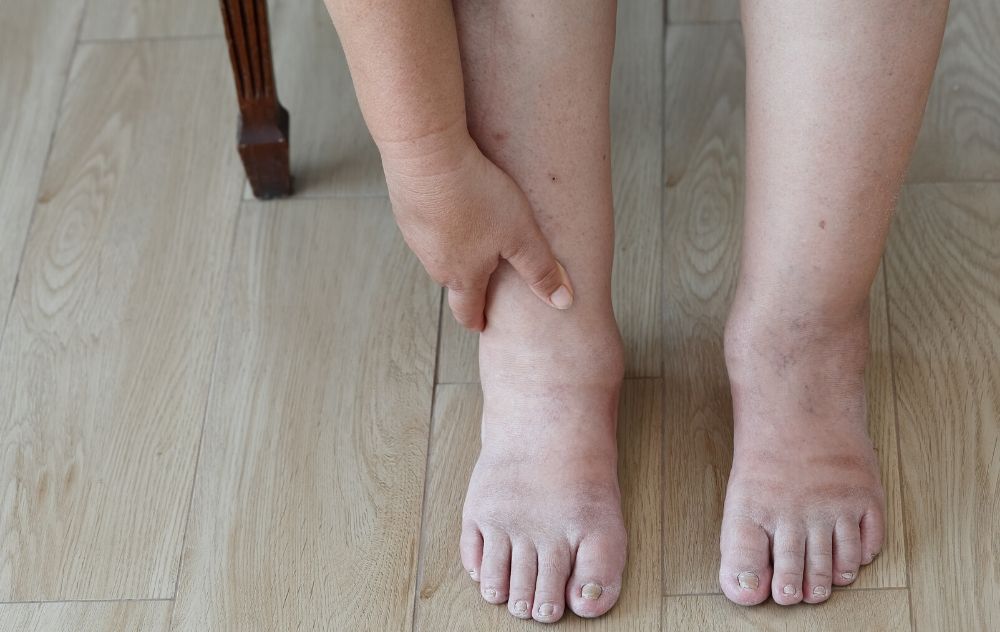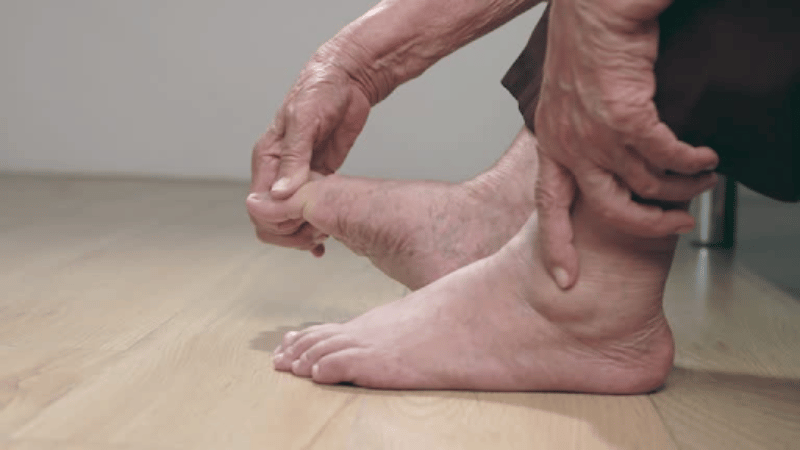Lower leg swelling happens for a variety of reasons. Many causes aren’t serious, like flying across the country, sitting down for long periods, or indulging in salty snacks. These activities can cause fluid to build up in the tissues of your legs, resulting in a puffy appearance. The medical term for swelling due to a build-up of fluid is edema.
In other cases, swollen legs can result from a more serious underlying condition related to the heart, kidneys, or circulatory system. One less commonly considered cause is peripheral artery disease (PAD).
In this article, we’ll explore ten possible causes of swollen legs and treatment options available if the cause is PAD.
TAKE OUR FREE PAD RISK ASSESSMENT
10 Reasons Why You May Have Swollen Legs or Feet
Swelling in the legs is typically caused by a build-up of fluids in the lower extremities. Excess fluid in the legs, ankles, and feet can be caused by various medical conditions. If PAD is causing swelling in your legs, schedule an appointment with a vascular specialist to create a treatment plan that fits your needs.
Here are ten common causes of swollen legs:
1. LIFESTYLE AND DIET
Common lifestyle choices can cause swelling in the legs and feet. Individuals who live a sedentary lifestyle can put additional stress on the lymphatic system, leading to a fluid build-up in the legs, ankles, and feet. Fluid build-up in the lower extremities can also be caused by diet choices and excessive sodium.¹
2. MEDICATIONS
Taking non-steroidal anti-inflammatory drugs (NSAIDs), some types of diabetes medications, steroids, estrogens, or high blood pressure medications can lead to swollen legs.
3. PERIPHERAL ARTERY DISEASE
Lastly, swollen legs and ankles can also be a sign of a serious condition called peripheral artery disease (PAD). This condition is caused by plaque accumulation in the arteries leading to your legs and feet. The plaque obstructs impeded blood flow, which means the tissues in your legs and feet can’t get enough nutrients and oxygen from your blood.
Other than swollen legs and feet, other common PAD symptoms to watch out for include leg pain while walking, shiny skin on the legs or feet, open sores that fail to heal, and slowed leg hair or toenail growth.²
If you have any symptoms or risk factors of PAD, schedule a consultation with a vascular specialist for an accurate diagnosis. When PAD is caught early, you can avoid severe plaque build-up and prevent your symptoms from worsening.
If you have any symptoms or risk factors of PAD, schedule a consultation with a vascular specialist for an accurate diagnosis. When PAD is caught early, you can avoid severe plaque build-up and prevent your symptoms from worsening.
SCHEDULE A CONSULTATION ONLINE
4. INFLAMMATION
Swollen legs and feet can also occur due to inflammation in the leg joints or tissues from an injury or disease. Common injuries that lead to leg inflammation include sprained ankle, broken ankle or foot, broken leg, inflammation in the knee, skin infection, and burns.
5. LYMPHEDEMA
Lymphedema is a medical condition caused by a build-up of lymphatic fluid in the lower extremities.³ Lymphatic fluid is a clear liquid that travels through the lymphatic system, helping to remove waste and fight infections in the body. A fluid imbalance can cause lymphatic system blockages, leading to swelling in the legs and feet.
Other symptoms of lymphedema include trouble walking, leg pain, and skin infections. Many individuals can address the pain by adjusting their lifestyle or receiving a manual lymphatic drainage massage. In some serious cases, surgical intervention may be necessary.
6. CONGESTIVE HEART FAILURE
When your heart weakens and is unable to pump blood effectively, it can lead to congestive heart failure. In this situation, fluid gets backed up, and excess fluid can lead to swelling in the legs, ankles, and feet.
7. KIDNEY DISEASE
The kidneys are responsible for maintaining chemical balances in the body and removing excess fluids from the bloodstream. Kidney diseases such as chronic kidney disease, acute kidney disease, and kidney stones impact your kidney’s normal bodily functions. Kidney disease also often results in excess sodium and fluids in your circulatory system, causing your legs to appear swollen. Other common symptoms include high blood pressure, itchy skin, increased urination, and muscle cramps in the legs or feet.
8. CHRONIC VENOUS INSUFFICIENCY
Chronic venous insufficiency is a serious medical condition that impacts the valves within the veins in the legs. These valves regulate blood flow in the lower extremities, ensuring blood flows in the right direction. If the valves are damaged, it can cause blood to pool in the legs, leading to swelling in the legs and feet. Other symptoms to look out for include pain when sitting, tingling, varicose veins, and skin discoloration.
9. DEEP VEIN THROMBOSIS
Deep vein thrombosis (DVT) occurs when a blood clot forms in the deep venous system, which impedes blood flow. Blood clots are more likely to happen in people whose veins are damaged. If you notice that one of your legs becomes painful and swollen but the other looks normal, seek emergency medical care. This can signify that a blood clot has formed, a potentially life-threatening condition requiring immediate treatment.
10. PREGNANCY
Pregnancy is also a common cause of swollen legs due to the extra fluids needed by the fetus and placenta.
Swollen Legs and Feet Management Tips
The appropriate treatment for swollen legs depends on the cause of the symptom. It’s best to see a doctor to determine if swelling in the legs is due to a serious medical condition. Here are some tips to help manage swelling in the legs if that’s not the case:
- Elevate your legs
- Exercise regularly
- Maintain a healthy body weight
- Manage your salt intake
- Stand up or move around at least once every hour
When Should I See a Doctor About Leg Swelling From PAD?
If the swelling is accompanied by cramping pain in the leg that doesn’t go away even when you’re sitting down, or you have ulcers on your legs or feet that won’t heal, reach out to a vascular doctor. These may be signs of advanced peripheral artery disease. At USA Vascular Centers, our expert vascular doctors offer several minimally invasive PAD treatments to help open blocked arteries.
If you have PAD and decide to delay treatment, you put yourself at risk of developing serious complications or critical limb ischemia. Critical limb ischemia is stage four PAD. Individuals with stage 4 PAD are at an increased risk of strokes, heart attacks, and amputation.
PAD Treatment Options Available
If diagnosed with PAD, a vascular doctor will then determine which minimally invasive treatment is appropriate for your situation. Common non-surgical PAD treatments available include:
- Angioplasty: A balloon-tipped catheter compresses the plaque against the artery walls.
- Mesh Stent Placement: Some angioplasties include a mesh stent placement to keep the artery propped open.
- Atherectomy: Involves using a catheter equipped with a laser or blade to shave and remove plaque from the artery wall.
It’s important to note that swelling in the legs and feet is common after a stent placement or angioplasty. Once your body has healed and blood flow to your lower extremities returns to normal, the swelling should subside. This can take a few days or weeks after the procedure.
At USA Vascular Centers, our highly skilled interventional radiologists perform these procedures. No general anesthesia or stitches are required, contributing to a shorter recovery time.
FIND A VASCULAR CENTER NEAR YOU
Schedule a Consultation With USA Vascular Centers Today
If you have swollen legs and think it may be due to PAD, call us or set up a consultation online. We have teams of vascular experts at locations nationwide that can help you find relief from painful symptoms using leading-edge, non-surgical treatments. Our state-of-the-art outpatient centers are certified by the Accreditation Association for Ambulatory Health Care (AAAHC), a testament to our commitment to providing high-quality patient care.
Our vascular center participates with most insurance plans, including Medicare and some Medicaid. Affordable payment options are also available for costs not covered by insurance. Contact us today to learn more.
TALK TO A VASCULAR SPECIALIST TODAY
Frequently Asked Questions
Why are my legs and feet swollen?
Non-serious risk factors like diet and lifestyle choices can cause swelling. However, swelling in the legs and feet (edema) can be a common and sometimes concerning symptom. While there are many potential causes, some of the most common include:
- Peripheral artery disease: PAD can lead to poor leg circulation, causing legs or feet to swell.
- Kidney disease: Impaired kidney function can lead to fluid buildup in the body.
- Heart failure: Weakened heart muscles can struggle to pump blood effectively, causing fluid to accumulate in the legs and feet.
If the swelling is paired with any other serious symptoms, consider scheduling a consultation with a vascular doctor for an accurate diagnosis.
Are swollen legs and feet dangerous?
Swollen legs and feet can be dangerous because swelling can indicate several medical conditions. Monitor your symptoms and consult a medical provider if other serious symptoms accompany the swelling.
How to reduce swelling in feet & legs?
If your legs and feet are swollen, elevate them, hydrate, and exercise. If the swelling persists after making modifications, schedule an appointment with a vascular doctor.
Sources
- Goyal A, Cusick AS, Bhutta BS. “Peripheral Edema: Overview,” StatPearls (StatPearls Publishing), https://www.ncbi.nlm.nih.gov/books/NBK554452/
- Yale Medicine. “Peripheral Artery Disease (PAD),” Yale Medicine, https://www.yalemedicine.org/conditions/peripheral-artery-disease-pad.
- Sleigh BC, Manna B. “Lymphedema: Overview,” StatPearls (StatPearls Publishing), https://www.ncbi.nlm.nih.gov/books/NBK537239/





